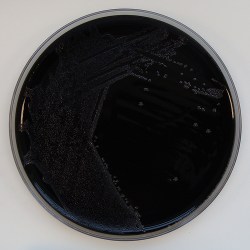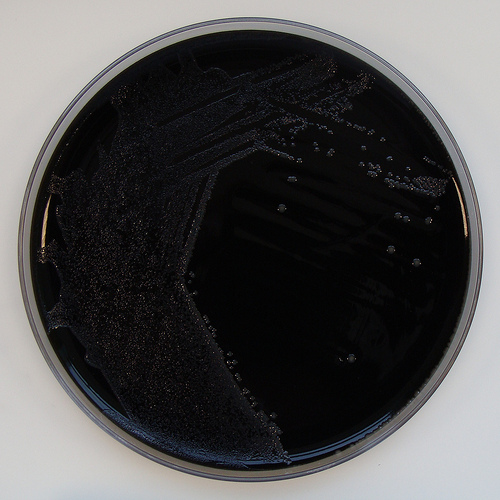
Whooping cough bacteria on a charcoal agar. Click to embiggen. (Photo by Nathan Reading.)
The Centers for Disease Control (CDC) suggests that 2012 will be the worst year for whooping cough since 1959. But don’t jump to the conclusion that the problem lies with the anti-vaccination crowd. For now, at least, the problem is more likely with changes in the vaccine itself.
Nearly 18,000 cases have been reported so far — more than twice the number seen at this point last year, the Centers for Disease Control and Prevention said Thursday. At this pace, the number for the entire year will be the highest since 1959, when 40,000 illnesses were reported.
Nine children have died, and health officials called on adults — especially pregnant women and those who spend time around children — to get a booster shot as soon as possible.
The CDC indicates that whooping cough outbreaks tend to come in waves. In 2004 and 2005, there were a lot of cases. In 2010, California saw one of its worst outbreaks ever.
Experts believe whooping cough occurs in cycles and peaks every three to five years. But they have been startled to see peaks this high. Vaccinations are supposed to tamp down the amount of infection in the population and make the valleys in the cycles longer, said Pejman Rohani, a University of Michigan researcher who is co-leader of a federally funded study of whooping cough trends.
Initial research from the CDC suggests that a weaker vaccine introduced in the 1990s may be to blame.
The vaccine that had been given to young children for decades was replaced in the late 1990s following concerns about rashes, fevers and other side effects. While the new version is considered safer, it is possible it isn’t as effective long term, said Dr. Anne Schuchat, who oversees the CDC’s immunization and respiratory disease programs. …
Some parents in California and other states have rebelled against vaccinations and gotten their children exempted from rules that require them to get their shots to enroll in school. Washington state has one of the highest exemption rates in the nation. But the CDC said that does not appear to be a major factor in the outbreak, since most of the youngsters who got sick had been vaccinated.
The anti-vaccination movement has, however, meant far fewer vaccinated students in schools. At the beginning of the last school year, California saw a record number of students enrolling without a complete set of vaccinations. This morning, it was reported that the state is seeing its largest whooping cough outbreak in 60 years.
Whooping cough is almost as contagious as measles, affecting ~12-17 individuals with each case, so clinicians are required to report cases of this bacterial respiratory tract infection to the state’s department of public health. This gave Kathleen Winter, MPH, and colleagues from the California Department of Public Health (CDPH) data on 9,154 cases of whooping cough with onset between January 1 and December 31, 2010; 809 cases were hospitalized and 10 resulted in death. All deaths and most of the hospitalized cases (62%) were in infants less than 3 months of age, and infants less than 6 months of age had the highest disease rates. In children and adolescents ages 1-18 years, Whites had the highest incidence.
The state legislature recently considered a bill that would require parents who decline immunizations to receive counseling from a doctor about the decision. That may not make much difference for those determined that their children should not be immunized; on one online forum, parents discuss ways to falsify vaccination records.
If the CDC is correct, though, the problem (for now) isn’t the lack of vaccination — it’s that the whooping cough vaccine across the board is not strong enough.



